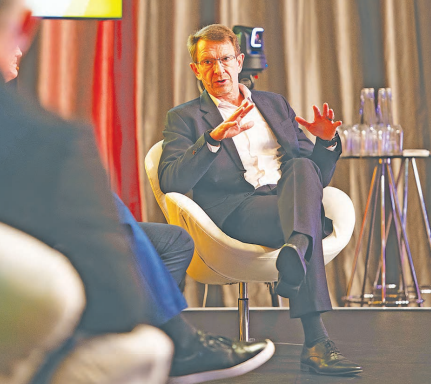Links key to boosting regional trade

JOHANNESBURG: AFRICA’S efforts to boost trade will stall unless governments and the private sector address the region’s transport networks, border policies and trade regulations, according to Mr Hennie Heymans, Chief Executive Officer of DHL Express Sub-Saharan Africa.
Speaking in Johannesburg, Mr Heymans said East Africa is at a turning point, with countries such as Tanzania well positioned to become major trade corridors.
But infrastructure and delays in policy implementation continue to hold back progress.
“It’s really hard to promote trade if you lack connectivity,” he said. “Only about 12 per cent of cities on the continent are connected through commercial aircraft at the moment. That is why DHL has invested in its own dedicated air network to overcome this gap.”
Mr Heymans explained that the obstacles to crossborder trade in the region can be grouped into two broad areas: weak implementation of existing policies and inadequate infrastructure.
He pointed to the African Continental Free Trade Agreement as an important framework that could drive trade, but noted that while the agreement exists on paper, its operational rollout across borders remains slow and uneven.
In his view, the real challenge is not the absence of policy but the pace and consistency with which it is applied in practical, everyday trade operations.
He said the infrastructure gap is equally significant. Poor road networks in many countries make it difficult to move goods efficiently.
Port facilities and railways remain congested or outdated and airports lack the level of connectivity needed to support modern logistics.
He acknowledged that some improvements have been made in certain areas, such as at Durban Port in South Africa that has recently recorded better performance, but said such progress is still too limited to make a substantial impact on continental trade flows.
This challenge, he argued, has forced companies like DHL to invest heavily in their own logistics capacity to bridge the gap. Air freight is particularly affected by low levels of commercial connectivity, making trade more costly and less reliable.
Without faster and more predictable transport networks, exporters and importers face delays and higher transaction costs, which ultimately reduce competitiveness.
The conversation then turned to the Standard Gauge Railway projects in Tanzania and Kenya.
Both governments have invested heavily in rail infrastructure to speed up the movement of goods from ports to inland destinations. Mr Heymans welcomed such investments but warned that infrastructure alone will not solve the problem if these projects are not well coordinated.
“If we have a fragmented approach, it creates more difficulty than solutions,” he said. “We need synergy in how these programmes are implemented and they should align with the AfCFTA framework to achieve economies of scale.”
For him, coordination is key: without it, even wellbuilt infrastructure can end up underused or misaligned with wider trade corridors.
ALSO READ: DHL sees rising trade potential in Tanzania
In Tanzania, DHL’s operations are concentrated in Dar es Salaam, but the company plans to extend its reach to other parts of the country. Mr Heymans said the expansion will be guided by the rise of what the company refers to as “second cities”, which are emerging as important commercial centres.
The company typically does this either by opening its own service stations or by partnering with independent retail operators.
Mr Heymans explained that such partnerships create opportunities for local businesses while allowing DHL to test market potential before committing to larger investments. This approach, already used in other African markets, provides flexibility and makes it easier to reach customers outside major urban centres.
Beyond infrastructure, Heymans placed strong emphasis on the role of small and medium-sized enterprises in driving trade. DHL’s GoTrade programme, which has already been introduced in Tanzania, focuses on helping SMEs understand and participate in cross-border trade. One of its key initiatives, Power Up Your Potential, provides training on customs procedures, export documentation and logistics planning.
We bring SMEs together and provide them with a curriculum that helps them understand how to trade across borders,” he said. “This has already taken place in Tanzania. Our hope is that as these SMEs grow, they’ll return to DHL as partners.”
While the programme has reached thousands of businesses across the continent, Heymans admitted that DHL does not have the capacity to follow up with every participant individually.
Instead, the expectation is that businesses equipped with better knowledge and skills will grow and build longer-term commercial relationships with logistics providers as their operations expand.
When asked about what advice he would give to the Tanzanian government and other stakeholders in the logistics sector, Heymans spoke about the importance of creating a business environment that encourages investment and formalisation.
He cited Rwanda as an example, where it takes just six hours to register a business, contrasting this with other countries where the process remains complex and lengthy.
“It’s about simplifying the ease of doing business,” he said. “In Rwanda, for example, it takes just six hours to register a business. That’s a powerful example for other African nations.”

representatives during the DHL Media Event in Johannesburg, South Africa.
Across the continent, only about 40 per cent of SMEs are formally registered, a figure that has serious implications for access to finance and for government revenue. Many entrepreneurs avoid formal registration because the process is cumbersome, which limits their ability to grow and restricts the government’s ability to broaden its tax base.
Heymans noted that improving the business environment does not require sweeping reforms overnight but can begin with straightforward administrative changes that make it easier for small firms to operate legally and efficiently.
He then pointed to examples of other countries in Sub-Saharan Africa where governments are working more closely with the private sector to address these issues. He cited Kenya, for example, has engaged with logistics companies to support the development of its agricultural export sector.
Ethiopia has opened up opportunities for SMEs in the textile industry. Mauritius and Rwanda have streamlined investment processes and Senegal has shown strong commitment to supporting SME participation through the GoTrade programme.
In his view, these experiences demonstrate that progress is possible when governments adopt practical measures to support business rather than over regulate it.
Heymans also discussed the sectors that he believes will shape Africa’s economic future. He identified energy, life sciences and e-commerce as the main drivers of growth in the coming years.
Recent energy discoveries in countries such as Namibia and Uganda and ongoing developments in Angola and Nigeria could reshape energy markets.
Meanwhile, the health and pharmaceutical sector is likely to expand steadily as populations grow and health infrastructure improves.
E-commerce, however, is emerging as one of the most dynamic areas of growth. The sector is currently valued at around 75 billion US dollars across Africa and is growing at an estimated six to seven per cent a year.
Heymans believes East African countries have a chance to position themselves as regional hubs for this growing market if they create the right regulatory and infrastructure environment.
“We have an opportunity to position ourselves as a hub,” he said. “That means looking at frameworks like special economic zones and asking whether they are fit for purpose.”
Most of Africa’s e-commerce growth to date has been inbound, with goods arriving from major global platforms. But outbound trade is growing too, driven largely by the African diaspora.
Products such as fashion and garments and beauty products are finding new markets abroad. Heymans said the region lacks a strong digital marketplace similar to Amazon that could help small businesses scale up their exports.
While many young entrepreneurs rely on platforms such as Instagram or TikTok to sell their goods, he argued that a more coordinated digital infrastructure would make it easier for African businesses to reach global buyers.
Another obstacle is knowledge. Many SMEs are hesitant to export because they do not fully understand the procedures involved.
“Exporting can be a fearful conversation for small businesses,” he said. “We can play a role in guiding them and helping them trade across borders.”
For him, training and capacity building are not optional extras but core components of unlocking the region’s trade potential.
When asked whether SMEs should focus on regional trade before attempting to export globally, Heymans said there is no single answer. It depends on the product and the market. Africa’s average GDP per capita is around 2,100 US dollars and disposable income levels vary widely from one country to another. Some products may find their market within the region, while others may be better suited to international consumers. What matters, he said, is that businesses understand their target markets and plan accordingly.
In his concluding remarks, Heymans returned to the question of infrastructure, policy and the role of small businesses. He said Tanzania has the geographical position and infrastructure investments needed to play a central role in connecting East Africa’s trade flows.
But for this to happen, governments and the private sector must align their efforts more closely. “The building blocks are there,” he said. “What matters now is how we connect them through better infrastructure, smarter policy and a stronger logistics backbone.”





